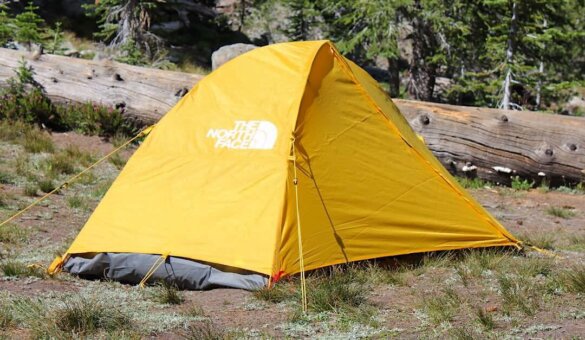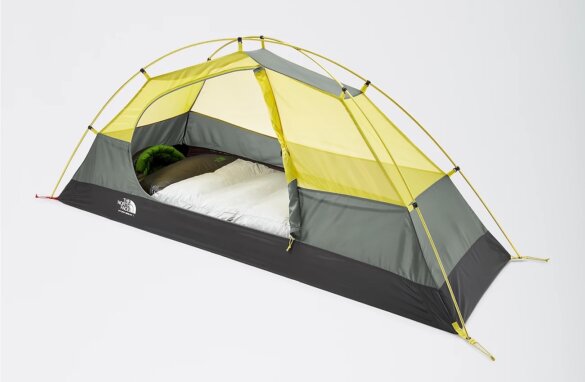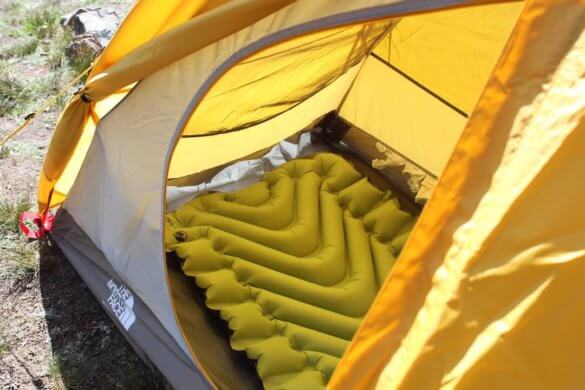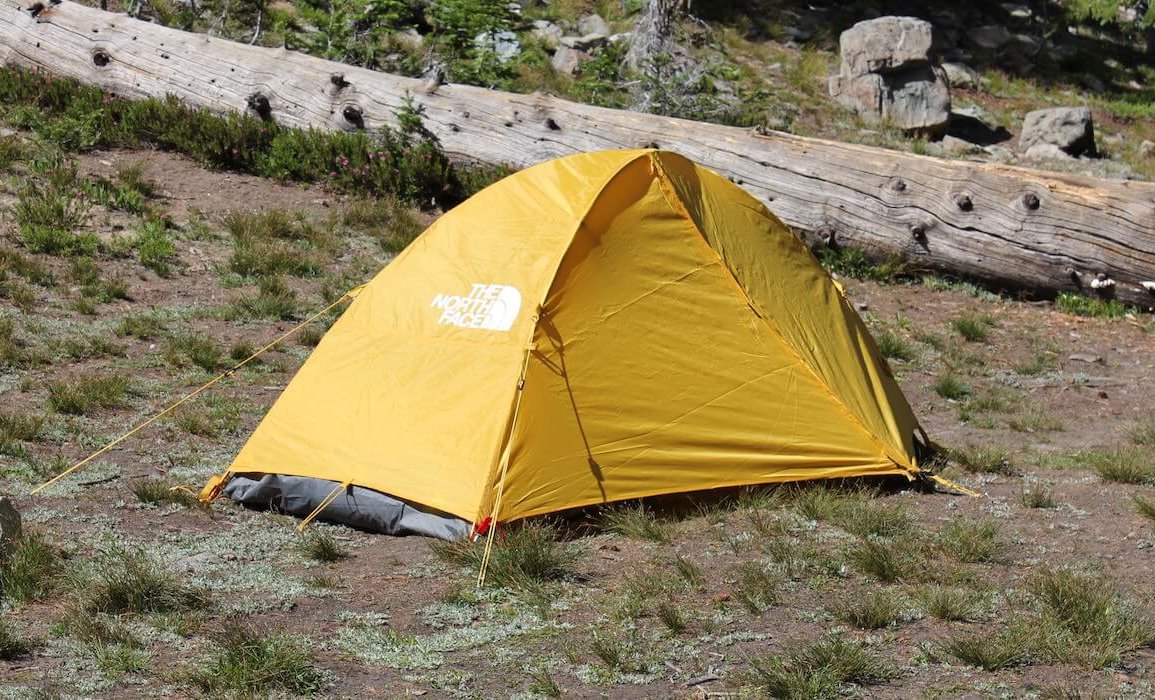The North Face Stormbreak 1 Tent has been a long-time favorite in the 1-person backpacking tent category, and for good reason: The North Face Stormbreak 1 is a great tent at a fantastic price point.
Coming in at about $150, the The North Face Stormbreak 1 uses a tried-and-true x-pole design. This is important to me personally because the pole design ensures that the Stormbreak 1 is a freestanding tent. In my experience, freestanding tents are easy to set up, easy to move, and they are typically faster to set up over varied and difficult terrain.
If you’re thinking about buying The North Face Stormbreak 1 Tent, I hope my experiences with it will help you identify if the Stormbreak 1 is the right 1-person tent for you.
I usually go backpacking with friends and family, and that usually means our crews are sharing 2-person or 3-person tents. Sometimes, though, you’ll be the odd man out, so you have a choice if you’re not willing to shell out hundreds of dollars for a high-end backpacking tent: Carry a heavier 2-person tent yourself or take a 1-person tent?

The North Face Stormbreak 1 weighs 3-pounds, 1.4 ounces, so taking a 1-person tent can save most recreational backpackers 1-2 pounds over a larger beginner-friendly tent. Because I also like to carry fly fishing gear and a solid first-aid kit, having a simple 1-person backpacking tent option is important as I’m loading up my pack.
After evaluating similar 1-person tents, I purchased The North Face Stormbreak 1 a several years ago for its freestanding design, durability and affordable price point. It’s been a great tent for recreational backpacking or for any camping situation where you need a quick and fast 1-person tent option. The North Face has since updated this tent with increased mesh for better airflow, but mine is still going strong.
I first tested The North Face Stormbreak 1 Tent backpacking in the Seven Devils Mountains in Idaho on a four-day backpacking trip. I’ve also found it handy for quick camping at trailheads and as an overflow tent on camping trips when we needed extra space. Because of its freestanding design, I’ve even pitched it in the back of my pickup at a trail head upon a very late night arrival.
Editor’s Note: We updated this review with new specifications and alternative 1-person tent comparison options to better help you find the best 1-person tent for you.
The North Face Stormbreak 1 Tent Review

The North Face Stormbreak 1 Specs:
- Capacity: 1 person
- Trail Weight: 3 lbs 1.4 oz
- Fast-Pitch Weight: 2 lbs 4.6 oz
- Floor Dimensions: 87″ x 34/26″
- Number of Doors: 1
- Number of Vestibules: 1
- Interior Height: 34″
- Packed Size: 6″ x 22″
Benefits:
- Excellent durability
- Freestanding, easy-to-pitch, good in wind
- Price-to-value ratio is outstanding
Drawbacks:
- Tapered floor reduces space for larger people
Shop the Stormbreak 1 with FREE shipping at:
_______________________________
How Do You Set Up The North Face Stormbreak 1 Tent?
The x-pole design on The North Face Stormbreak 1 Tent makes it easy to set up. Here is how you set it up:
- Spread the tent out, extend the poles, then place the pole ends into the perfectly sized holes in the straps at opposite corners. This will bend the poles and create a curved x-shape over the top.
- Raise the tent body by using the pole clips to attach to the poles.
- Toss the rain fly over the top and clip the corners of the fly into the matching corners of the tent’s floor. The clips are color-coordinated so it’s easy to get right.
- Make adjustments by tighten the corner straps, connect the fly to the poles with the attached connectors, and stake it all down with the included stakes.
That was probably harder to read than it is to do in real life — The North Face Stormbreak 1 Tent setup is one of the fastest and simplest tents I’ve ever pitched.
Interior Space Considerations

At the shoulders inside your tent, you’ll have about 34 inches of width, which tapers to 26 inches at your feet. The length is 87 inches. To put that in perspective, typical backpacking sleeping pads are 20-24 inches wide and 72 inches long. The interior peak height is about 34 inches. The Stormbreak 1 is roomy enough for geting dressed, sleeping, or waiting out a storm.
I’m about 6’3″ and 225 pounds and I fit in the Stormbreak 1 pretty well. If you’re a little larger than I am, you might consider the similarly designed REI Trailmade 1 Tent, which is 88″ x 36.5″ inches wide. It doesn’t taper at the feet, so you get a bit more shoulder, knee and foot room. It also has a 41″ interior peak height, which is 7″ higher than the Stormbreak 1 interior height.
The Stormbreak door is fairly large and zippers open easily for entry and exit.
The vestibule over the door is about average in size, giving you room to stow your hiking boots and your backpack under the rain fly. The side without a door has a very small vestibule that you could use to stow hiking boots or something small, but it’s not accessible from inside the tent. The latest version of The North Face Stormbreak 1 Tent has increased mesh for improved ventilation, which also makes the interior feel a bit roomier than earlier models that had less mesh.
Do I Need the Stormbreak 1 Footprint?
The North Face Stormbreak 1 Tent does not come with a footprint included. What’s a footprint? A footprint is basically a perfectly matched lightweight ground tarp that you can place under your tent to help protect the floor from sharp rocks, sticks or pinecones.
Aside from a bit more ground protection, you can use the Stormbreak 1 Footprint to pitch the Stormbreak in a fast-pitch mode with just the rain fly and footprint. In this case, you could leave the mesh body of the tent behind to save weight. I like to use fast-pitch options to save weight when I’m backpacking later in the season when mosquitoes are no longer out in force.
The North Face Stormbreak 1 Tent Review: Affordable Quality
The surprise for me was the quality built into the Stormbreak 1 tent. The aluminum poles and clips are all robust. The sealed seams are great and have held up to bad rainy weather and gusty wind. The zippers on the door and fly work great, too. The materials aren’t necessarily super ultralight, but they’re all reasonably light. Plus, the polyester bathtub floor and fly are tough enough to handle a few seasons of abuse and keep the rain out.
You can certainly find lighter backpacking tents or tarp systems made with thinner materials for two or three times the cost, but with the Stormbreak series, The North Face has created a total package that comes together to create an affordable, high-quality entry-level tent. All-in-all, it’s hard to go wrong with The North Face Stormbreak 1 Tent. The quality is there, the price is right, and overall design is simple and dependable. Highly recommended.
Get the Gear:
Stormbreak 1 Tent Alternative Options Chart:
| 1-PERSON TENT NAME | WEIGHT | FLOOR | PROS | CONS | PRICE |
| The North Face Stormbreak 1 | 3 lbs 1 oz | 87″ x 34/26″ | Awesome value | Tapered floor | $150 |
| Alps Mountaineering Lynx 1P | 3 lbs 5 oz | 90″ x 32″ | Good value | Less rugged | $100 |
| Kelty Discovery Trail 1P | 3 lbs 6 oz | 87″ x 31″ | Lots of mesh | Least shoulder width | $115 |
| REI Trailmade 1 | 3 lbs 8 oz | 88″ x 36.5″ | Footprint included | Higher cost | $179 |






